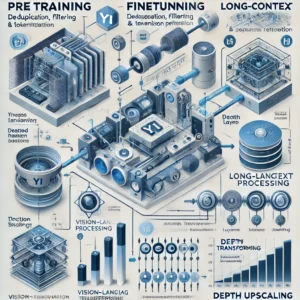The field of Artificial Intelligence is no stranger to innovation, but the introduction of DeepSeek-V2 represents a significant breakthrough in developing efficient and scalable language models. With a focus on balancing top-tier performance and reduced computational costs, DeepSeek-V2 sets a new benchmark for open-source models. This blog explores the architecture, innovations, and real-world implications of this cutting-edge Mixture-of-Experts (MoE) model.
What is DeepSeek-V2?
DeepSeek-V2 is a Mixture-of-Experts (MoE) language model boasting 236 billion total parameters, with only 21 billion activated per token, ensuring efficient use of computational resources. It supports an extensive context length of 128,000 tokens, making it adept at handling long-form content and complex queries.
This model is designed to address the challenges posed by traditional dense models, such as high computational costs and memory bottlenecks during inference. DeepSeek-V2 achieves this through a suite of innovative architectural and training strategies.
Innovations in DeepSeek-V2
1. Multi-Head Latent Attention (MLA): Boosting Inference Efficiency
Traditional attention mechanisms like Multi-Head Attention (MHA) demand substantial memory for key-value (KV) caching during inference. DeepSeek-V2 introduces MLA, which leverages low-rank joint compression of keys and values to drastically reduce the KV cache requirements while maintaining superior performance.
- KV Cache Reduction: MLA reduces the KV cache size by 93.3% compared to the previous DeepSeek 67B model.
- Inference Speed: MLA increases the maximum generation throughput by 5.76x, enabling faster and more scalable deployment.
2. DeepSeekMoE: Economical and Effective Training
The DeepSeekMoE architecture refines the standard MoE framework by incorporating:
- Fine-Grained Expert Segmentation: Enhances expert specialization and knowledge acquisition.
- Shared Expert Isolation: Reduces redundancy and ensures efficient routing.
This design allows DeepSeek-V2 to outperform conventional MoE models while reducing training costs by 42.5%.
Training and Alignment Strategies
Pretraining
DeepSeek-V2 is pretrained on a high-quality, bilingual dataset containing 8.1 trillion tokens. This dataset emphasizes English and Chinese content, ensuring robust multilingual capabilities.
Key aspects of pretraining include:
- Quality Filtering: Advanced algorithms to remove non-beneficial or biased data.
- Extended Context Training: Use of techniques like YaRN to scale the model’s context window up to 128K tokens.
Alignment
To fine-tune its capabilities and align with human preferences, DeepSeek-V2 undergoes:
- Supervised Fine-Tuning (SFT): Improves accuracy in tasks like math, coding, and natural language understanding using a carefully curated dataset of 1.5M instruction-response pairs.
- Reinforcement Learning (RL): Adopts Group Relative Policy Optimization (GRPO) to enhance decision-making and response quality.
Performance Highlights
DeepSeek-V2 demonstrates state-of-the-art performance across a range of benchmarks, outperforming previous models like DeepSeek 67B and competitive open-source models. Some key results include:
- MMLU Accuracy: Matches or exceeds models with significantly more activated parameters.
- Math and Code Benchmarks: Achieves top-tier scores in GSM8K and HumanEval.
- Multilingual Proficiency: Excels in both English and Chinese evaluation datasets.
Why DeepSeek-V2 Matters
Efficiency Without Compromise
DeepSeek-V2 exemplifies the power of sparse computation, achieving efficiency without sacrificing performance. Its ability to activate only a fraction of its total parameters for each token results in significant cost and memory savings.
Accessibility and Scalability
The model’s reduced computational footprint enables deployment on accessible hardware setups, democratizing the use of advanced AI in research and industry.
Real-World Applications
With its capabilities, DeepSeek-V2 is well-suited for:
- Enterprise Chatbots: Handling extensive conversational contexts efficiently.
- Scientific Research: Supporting complex data analysis with long-context reasoning.
- Multilingual Tools: Facilitating cross-language communication and content generation.
Looking Ahead
DeepSeek-V2 represents a paradigm shift in how we approach large language models. By optimizing resource usage and enhancing inference capabilities, it paves the way for a future where advanced AI models are accessible, sustainable, and impactful.
The journey doesn’t stop here. The release of DeepSeek-V2 Lite, a smaller variant with similar innovations, underscores a commitment to open-source collaboration and innovation. As AI continues to evolve, models like DeepSeek-V2 will play a pivotal role in shaping its trajectory.
Explore the full potential of DeepSeek-V2 by accessing its open-source repository on GitHub.






Be First to Comment